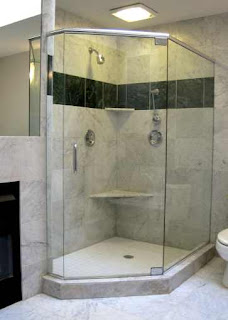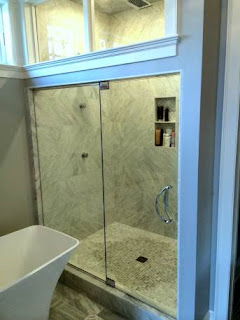 A couple of weeks ago at the Minneapolis Home & Garden
Show, there were a handful of people that stopped by with questions about the
difference between pivot and side-mounted frameless shower door hardware. I’m
pretty sure the sudden influx of questions regarding this was due to another
glass company at the show, new to the Twin Cities glass scene, which only
installs pivot hinges. They were telling showgoers that pivot hinges were the
superior application because side hinges will begin to sag over time. Now, this
is a great marketing ploy if your franchise only carries pivot hinges - turn
your shortcoming into a distinction! It is, however, complete nonsense… Ask any reputable shower glass company or the
hundreds of thousands of homeowners who love their heavy glass showers. Quality
hardware, properly installed is durable enough to support the weight of that
door for a long time to come no matter where it hinges.
A couple of weeks ago at the Minneapolis Home & Garden
Show, there were a handful of people that stopped by with questions about the
difference between pivot and side-mounted frameless shower door hardware. I’m
pretty sure the sudden influx of questions regarding this was due to another
glass company at the show, new to the Twin Cities glass scene, which only
installs pivot hinges. They were telling showgoers that pivot hinges were the
superior application because side hinges will begin to sag over time. Now, this
is a great marketing ploy if your franchise only carries pivot hinges - turn
your shortcoming into a distinction! It is, however, complete nonsense… Ask any reputable shower glass company or the
hundreds of thousands of homeowners who love their heavy glass showers. Quality
hardware, properly installed is durable enough to support the weight of that
door for a long time to come no matter where it hinges.
That said, as a Minneapolis glass company that installs both
pivot and swing style doors, we think it’s important that our customers are
well-informed about both options so they can decide which application works
best for their bathroom. Here’s the lowdown on the benefits and drawbacks of
the two styles.
Side-Mounted Hinges
Swing doors work pretty similar to other doors around your
home, except they have a 180-degree range of motion. Some glass companies use
two hinges on these doors, others three. We find the third (middle) hinge to be
superfluous since it doesn’t gain you anything – it doesn’t support a wider or
heavier door, for example. Side-mount
hinges are either anchored to a 2x stud behind the tile and drywall on the side
of the enclosure or attach to an adjacent glass panel. The nicest thing about
swing doors is that you can go to any height you’d like, most commonly in the
72-80” range up from the curb, but we’ve done some on larger walk-ins where
they cut the door short, giving it a half-saloon style.
Of course, the shorter the door, the less expensive the door. Another great cost saving aspect of this type of door is the fact that it doesn’t require a header since it is supported at the side, not the top. Beyond price, this is a big plus for homeowners wanting to achieve that truly frameless look. So, what are the drawbacks of this style door? This one is pretty subjective, but some people just prefer the look of a pivot door. With a swing door, side-hinges interrupt that unencumbered sightline of solid glass that allows you to forget pivot hinges even exist. The other shortcoming of the swing door is the fact that although you can go pretty tall with these, at a certain point you’ll be forced to use a transom panel above the door if you want a steam shower in an enclosure with high ceilings. On the flipside, this is as much of a selling point as a drawback. Operable transoms are a great way to vent steam showers, plus they add visual intrigue to the overall shower design.
Of course, the shorter the door, the less expensive the door. Another great cost saving aspect of this type of door is the fact that it doesn’t require a header since it is supported at the side, not the top. Beyond price, this is a big plus for homeowners wanting to achieve that truly frameless look. So, what are the drawbacks of this style door? This one is pretty subjective, but some people just prefer the look of a pivot door. With a swing door, side-hinges interrupt that unencumbered sightline of solid glass that allows you to forget pivot hinges even exist. The other shortcoming of the swing door is the fact that although you can go pretty tall with these, at a certain point you’ll be forced to use a transom panel above the door if you want a steam shower in an enclosure with high ceilings. On the flipside, this is as much of a selling point as a drawback. Operable transoms are a great way to vent steam showers, plus they add visual intrigue to the overall shower design.
Pivot Hinges
 As I mentioned in the previous section, the great boon of
pivot hinges is the uninterrupted glass surface from top to bottom that can
make you forget that the hardware even exists. Furthermore, they are especially
nice when you want a door to trap moisture in a walk-in shower since walk-ins are
often framed in by a lower header. This style door also offers a 180-degree
range of motion. That’s about all I can say regarding the benefits of pivot
hinges – now for the drawbacks. Hinging from the top and bottom as pivots do
creates a host of issues. The single greatest mark against them is that
securing the bottom hinges requires drilling into the threshold which is really
something to be avoided at all costs. Ask anyone involved in nearly any aspect
of the construction industry, moisture is the enemy and it is a relentless one.
Drilling into the shower curb means that you’re piercing the PVC shower pan
liner, the waterproofing membrane that is the last line of defense against
water incursion. This doesn’t necessarily lead to a worst case scenario of rotting
drywall and a crumbling ceiling downstairs, but you are creating a weakness in
a barrier that’s designed to be impenetrable, and that’s clearly not something
you want.
As I mentioned in the previous section, the great boon of
pivot hinges is the uninterrupted glass surface from top to bottom that can
make you forget that the hardware even exists. Furthermore, they are especially
nice when you want a door to trap moisture in a walk-in shower since walk-ins are
often framed in by a lower header. This style door also offers a 180-degree
range of motion. That’s about all I can say regarding the benefits of pivot
hinges – now for the drawbacks. Hinging from the top and bottom as pivots do
creates a host of issues. The single greatest mark against them is that
securing the bottom hinges requires drilling into the threshold which is really
something to be avoided at all costs. Ask anyone involved in nearly any aspect
of the construction industry, moisture is the enemy and it is a relentless one.
Drilling into the shower curb means that you’re piercing the PVC shower pan
liner, the waterproofing membrane that is the last line of defense against
water incursion. This doesn’t necessarily lead to a worst case scenario of rotting
drywall and a crumbling ceiling downstairs, but you are creating a weakness in
a barrier that’s designed to be impenetrable, and that’s clearly not something
you want. That’s the problem with the bottom hinge, here’s the issue
with the top. Like the bottom hinge, it needs to anchor into something. There
are several ways to do this and problems arise with each. To achieve the
signature uninterrupted look that pivot doors are known for requires the door
to extend to the ceiling - arresting in appearance, but hard on the wallet if
you have high ceilings. The alternative is to use a header across the top,
which lowers the door cost, but substantially increases the hardware cost. Some
people feel that it diminishes the frameless appeal sought in a heavy glass
shower. The final option also requires more costly hardware.
That’s the problem with the bottom hinge, here’s the issue
with the top. Like the bottom hinge, it needs to anchor into something. There
are several ways to do this and problems arise with each. To achieve the
signature uninterrupted look that pivot doors are known for requires the door
to extend to the ceiling - arresting in appearance, but hard on the wallet if
you have high ceilings. The alternative is to use a header across the top,
which lowers the door cost, but substantially increases the hardware cost. Some
people feel that it diminishes the frameless appeal sought in a heavy glass
shower. The final option also requires more costly hardware.
This application is an L-shaped hinge that anchors to the side wall, but extends over the door to hinge at the top. The last thing I’d like to mention is the fact that you’re unable to use an operable transom over pivot hinges which can be an issue if you have a steam shower and you lack a vent inside the enclosure.



